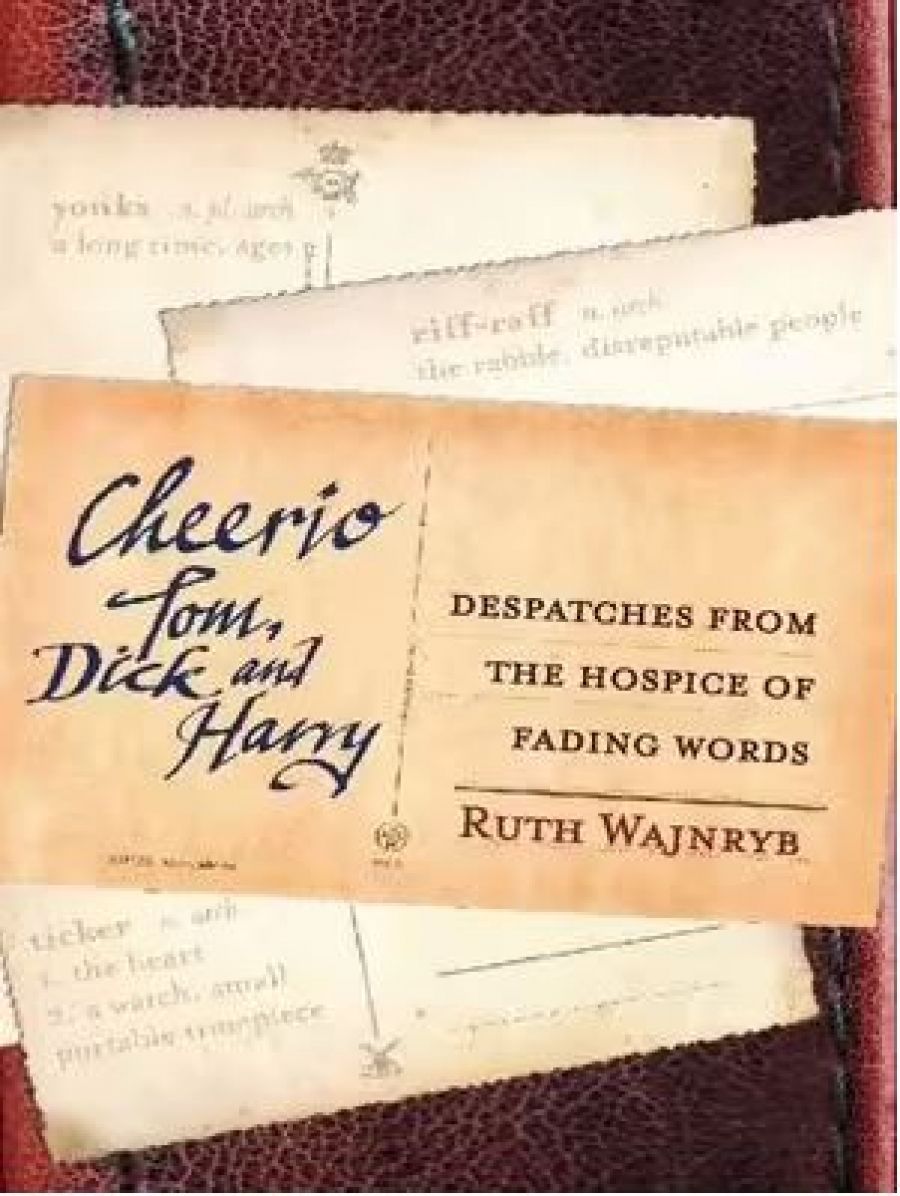
- Free Article: No
- Contents Category: Language
- Review Article: Yes
- Article Title: Hospice for mortal words
- Online Only: No
- Custom Highlight Text:
This is a book about words that are on their way to the dictionary cemetery where they will be stamped with the labels ‘archaic’ or ‘obsolete’. Of course, unlike us, these dying words will achieve a kind of eternity through being permanently displayed in dictionaries, but the time will come when no living person possesses them as part of their actual speech. Ruth Wajnryb proposes that a hospice should be set up to provide sanctuary and comfort for these weary and largely forgotten lexical bits and pieces, a ‘hospice of fading words’.
- Book 1 Title: Cheerio Tom, Dick and Harry
- Book 1 Subtitle: Despatches from the hospice of fading words
- Book 1 Biblio: Allen & Unwin, $24.95 pb, 264 pp
- Book 1 Readings Link: https://www.booktopia.com.au/cheerio-tom-dick-and-harry-ruth-wajnryb/ebook/9781741760460.html
As with these ‘hat’ expressions, many of the words in this book are suffering the pain of obsolescence because of changes in fashion and technology. Does anyone ‘darn’ socks in this throwaway world in which ‘planned obsolescence’ is the manufacturers’ credo? Did you notice, asks Wajnryb, when Myer closed down the ‘haberdashery’ section in its stores? The word ‘haberdashery’ went the way of the tinker, the mercer and, if anyone remembers, napery. Some of these changes occur quickly. The quill pen and the gramophone faded gracefully, but no such grace for the speedy demise of the video cassette recorder or the floppy disk. Many idioms fade simply because they were entrenched in a world that no longer exists (‘the penny drops!’), and many of the expressions that Wajnryb notes are Australian: ‘what do you think this is – bush week?’; ‘a wigwam for a goose’s bridle’; ‘up in Annie’s room behind the clock’; ‘shoot through like a Bondi tram’.
The book is aimed at a general audience, but even so I thought the arguments could have been a bit more historically rigorous at times. Take, for example, chapter eighteen on rhyming slang, a slice of language that Wajnryb feels will require a whole ward, or even a wing, of the hospice. Is it really credible that rhyming slang was developed by the London underworld as a secret language from the 1850s, when most of its meanings are transparent and most of its manifestations utterly removed from the world of crime? If the 1850s in London is the time of its beginnings, how do we explain the use of ‘jimmygrant’ as rhyming slang for ‘emigrant’ in New Zealand by 1845, and in Australia by 1859 (replaced, of course, later, by ‘pomegranate’ and hence ‘pom’)? Can we attribute Australian rhyming slang to British influence when the most productive period for the creation of rhyming slang in Australia was World War II? I would agree that rhyming slang is largely obsolescent in Australia, but there seems to be a resurgence of it in Britain, especially among the young, suggesting that there are important regional differences in the process of obsolescence (as in Australia, for example, in the use of’ cock’ as a term of address, and ‘rum ‘un’ for ‘strange one’, in Tasmania).
A book of this kind inevitably has a structural problem. Since there is no developing story or argument, and since each chapter provides a different set of examples of the same phenomenon, it starts to sound a bit repetitive. It is in response to this, I think, that some of the later chapters are more about the developments of new words (new words for ‘food’) or about new ways of talking in a changing world (the discussion of how parents might give advice to teenagers) than about the dying words.
Nevertheless, this remains throughout a very entertaining book. For those of us who still use many of these words and expressions, it is a shock to be reminded of how obsolescent both we and our words are. For a younger audience, this will be like a walk through a museum where the displayed objects occasionally evoke glimmers of living voices – or like the final visit to the hospice before the loved one ‘shuffles off this mortal coil’, ‘crosses over’, ‘cashes in his chips’, concludes his ‘three score and ten’, ‘dies in the harness’ or simply ‘goes away’.


Comments powered by CComment